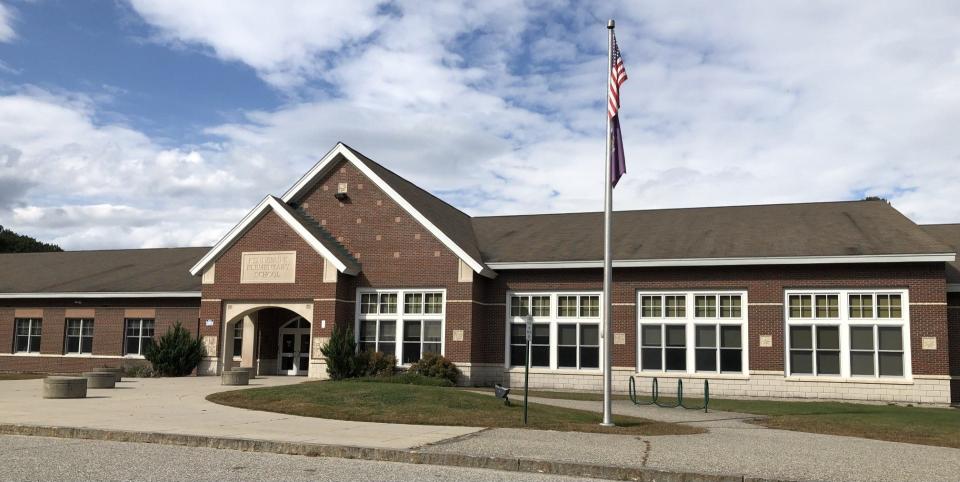Mold outbreak at Kennebunk Elementary School raises health concerns
KENNEBUNK, Maine — Efforts continue to rid Kennebunk Elementary School of the mold that has infested areas throughout the building as a result of the high humidity and frequent heavy rains the region experienced this past summer.
The issue surfaced last month, when EOC Environmental, a consulting firm, conducted an investigation at the school at the district’s request on Sept. 14. The district’s facilities department reached out to the company after observing “suspect growth” in classrooms throughout the north, east and west wings of the school.
According to an EOC report, “suspect growth” was found on shelves and contents of those shelves, as well as on a filing cabinet in one case, in the following classrooms: E102, E103, E109, C136, and D116. EOC also took air samples from rooms E109, E102, E103 and C136 that showed “significantly elevated” levels of a mold called aspergillus-penicillium.
Room E109, in particular, had “very heavy” spore estimates, according to the report.

During the past few weeks, Servpro, a cleaning company, has been remediating affected rooms, custodians have extensively sanitized wings throughout the school, and EOC Environmental has been testing samples and reporting results, RSU 21 Superintendent Terri Cooper said in a message to staffers and families.
Earlier this week, contractors remediated and tested the air in four rooms, E103, E109, E106, and E123, according to RSU 21 Operations Director Richard Terwilliger-Smith. As well, dozens of air samples were taken from all classrooms, plus the school’s library, art room, board room, parks and recreation room, and cafeteria, according to Terwilliger-Smith.
“Out of an abundance of caution, we feel that this is the best course of action,” Terwilliger-Smith said in a memo to staff and families on Oct. 6.
On Oct. 11, RSU 21 spokesperson David Singer said the results of those dozens of samples should be known by next week. Singer added that mold reports are available on RSU 21’s official website.
What are the health dangers of mold found in classrooms?
According to the Center for Disease Control and Prevention, aspergillus is a common mold that grows indoors and outdoors.
“Most people breathe in aspergillus spores every day without getting sick,” the CDC says on its website. “However, people with weakened immune systems or lung diseases are at a higher risk of developing health problems due to aspergillus.”
For such individuals, the mold can cause allergic reactions and infections in the lungs and other organs of the body.
Aspergillosis is a disease that the mold can cause, according to the CDC.
“Some types are mild, but some of them are very serious,” the CDC said.
During a School Board meeting on Sept. 25, Terwilliger-Smith described aspergillus-penicillium as a mold that likes to grow in humid environments where there are food, plants and dirt.
“It’s very tough to see,” Terwilliger-Smith said. “Our custodians probably wouldn’t have recognized it or seen it. It took a professional to come in with special lights to find it.”
Megan Cooper, a parent of an immune-compromised child at KES, spoke at the meeting. She cited Environmental EOC’s report, which stated that workers remediating the affected rooms should be equipped with a full array of protective gear.
“Yet our children are still attending school every single day since this report was shared,” Cooper said. “I would like for the board to really seriously consider the safety of our youngest students in the community.”
KES staff members and families first learned about the issue on Sept. 20, when KES Principal Ryan Quinn sent a message alerting them that mold had been discovered at the school. In his message, Quinn said that affected rooms were closed and would remain so until cleaned and until remediation plans were in place.
"Every room in the school will be treated and cleaned," Quinn said. "The health, safety and well-being of our students and staff remain our highest priority."
As a result of the situation at KES, all schools in RSU 21 are being tested for mold. The district has schools in all three towns it comprises, Kennebunk, Kennebunkport, and Arundel.
This isn't the first time RSU 21 schools have had a mold problem
RSU 21 has contended with mold in a local school before. In 2010, the Coast Star reported that a team from the National Institute for Occupational Safety and Health visited the Middle School of the Kennebunks and reviewed staff medical records and reports on air quality testing that had been done there.
The district had invited the institute to MSK to get to the bottom of air quality concerns that staff members had raised. In late 2009, more than 60 staff members asked to be removed from the school as a result of such concerns. In late 2010, the staff members asked that the school be outright closed and repaired or that portable classrooms be brought onto the premises.
The school had experienced structural issues, such as water leaks, in the years since it opened in 2002. Even after the district spent more than $300,000 on addressing mold concerns between 2008 and 2010, staff members reported that they were still experiencing symptoms, including runny noses and eyes, headaches and respiratory issues.
This article originally appeared on Portsmouth Herald: Kennebunk Elementary School struggles with mold infestation

